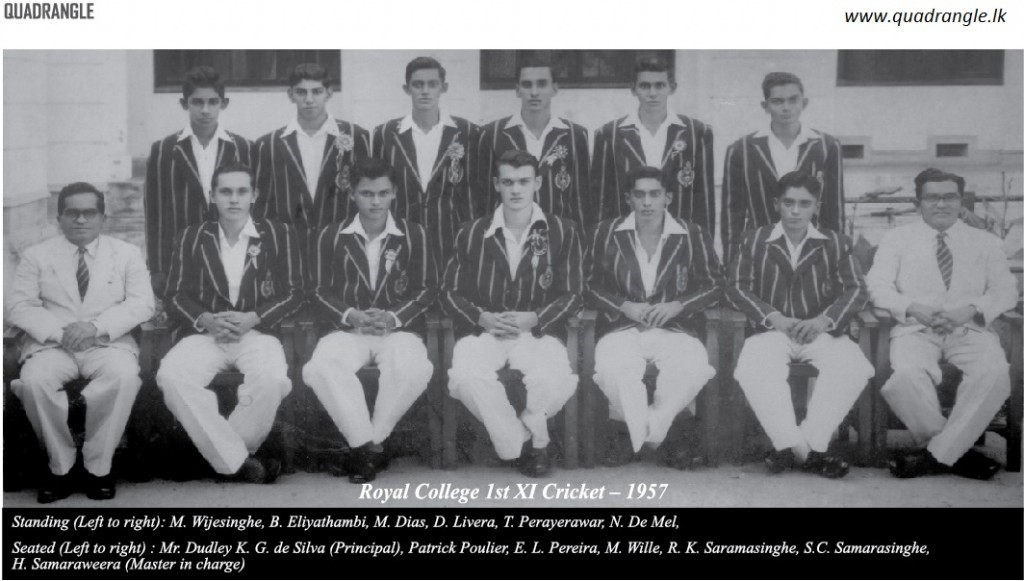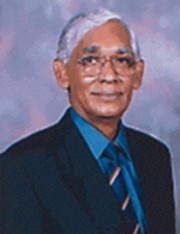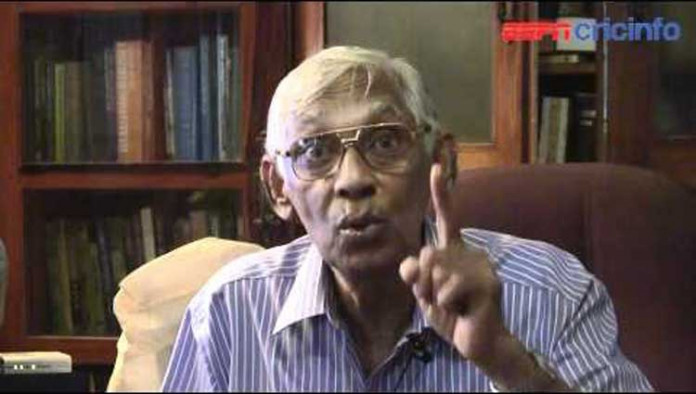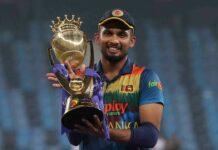Over the years, the gentlemen’s game has gone through rapid transformations and technology has played a vital role in this. Today from concepts such as hotspot, ball tracker to reviews, technology is used to reduce human error in decisions.
Perhaps the watershed moment of the use of technology came with the introduction of the TV Umpire in the early 90s. Perhaps it is an unknown fact that it was a Sri Lankan who pioneered this momentous makeover in cricket. He is the former cricketer, historian, innovator and acclaimed writer Mahinda Wijesinghe.
4 wickets in 4 balls

When Lasith Malinga nearly stunned the South Africans with daylight robbery in 2007, many did not know that he emulated a record which was set 50 years ago by a schoolboy.
Mahinda Wijesinghe, as a 16 year old schoolboy cricketer for Royal College, claimed 4 wickets in 4 deliveries against Ananda College at Campbell Place in 1957. His left arm spin created a record in schools cricket, one that is yet to be broken. In the same season he captured 12 wickets against Zahira College while he and his teammate Lorenz Pereira were known as the best spin combination that season. Nifty with the bat, he was involved in a match saving partnership with Michael Dias to save Royal against a champion St. Benedict’s College team. He later joined Bloomfield and still holds the distinction of being named the Best Batsman in Mercantile cricket in divisions ‘A’, ‘B’ ‘C’ & ‘’D’. He was deputy to Noel Perera during Saravanamuttu Trophy series and when Bloomfield became champions in the 1963/64 season. His heroics were well regarded especially at a time when the champions did not even have a ground of their own.
Concept of a TV Umpire
In 1981 Mahinda Wijesinghe became the Executive Secretary of the Sri Lanka Cricket Foundation where he worked tirelessly to introduce indoor cricket nets for practice sessions. At the same time, he was a freelance writer when in 1982, he wrote an article to ‘The Island’ newspaper about using a ‘Walkie-Talkie’ system between the on-field umpire and the umpire in the pavilion. During a disputed decision, the field umpire can receive assistance from the umpire in the pavilion who is seated in front of a TV. This umpire, using the cameras which are installed, can advise the on-field umpire about the correct decision.
His concept was considered by Sri Lanka Cricket and then Chairman, late Gamini Dissanayake, who then forwarded the suggestion to the ICC since an individual couldn’t send proposals directly to the ICC. The concept was put to discussion at the ICC AGM in 1984.
The Secretary of SLC attended the AGM at London in 1984 and when asked further questions about the concept, he was unable to give necessary explanation which led the ICC to drop the idea. Countries like South Africa quickly adopted this new concept. British journalist and commentator late Christopher Martin-Jenkins regarded Mahinda Wijesinghe as the forefather of this concept as a result of this. If not, his valuable contribution would have been forgotten in the cricketing world. In 1986, Sir Donald Bradman, writing to Wijesinghe, too acknowledged his concept “I fully understand and appreciate your concern on certain aspects of cricket as you have set out”
A watershed moment in 1992
A historical moment (Video courtesy – robelinda2)
The concept he pioneered came into the international stage during India’s tour of South Africa in 1992. The series held another historical milestone as it included South Africa’s first home Test since 1970. The rainbow nation also featured their first ever non-white player, Omar Henry.
At the Durban Test in November 1992, Karl Liebenberg appeared as the first ever TV umpire in the history of cricket. During the second day, India were reeling amidst a brutal spell by Brian McMillan when a throw by Jonty Rhodes from point to Andrew Hudson saw a close call for a run out on 19-year old Sachin Tendulkar. Square leg umpire Cyril Mitchley, requested assistance from Liebenberg, who after closely analyzing the replays, decided that the batsman was out. Tendulkar had to depart, becoming the first batsman in history to be given out by a TV umpire. Interestingly, Liebenberg used the ‘green light’ to indicate that Tendulkar has to leave the ground.
Skipper Kepler Wessels, who made history in the Durban Test by becoming the first batsman to score centuries for two different countries, later in the ODI series, became the first batsman to be given out by a TV umpire in limited overs format. During the 2nd ODI at Cape Town, he was run out by Ajay Jadeja, which was ruled by TV umpire Rudi Koertzen.
Challenging the MCC and helping Murali

Mahinda Wijesinghe valiantly challenged the existing laws of MCC. As a correspondent to ‘Cricket International’ in 1987, he suggested that the webbing on the wicketkeeper’s glove should be reduced. On another occasion he pushed the MCC to credit the bowler for the dismissal of batsman handling the ball. His argument was that if a LBW is given to the credit of the bowler which is an accidental action by the batsman, why a more intentional error such as handling a ball (when the ball goes to hit the stumps or pads in line) is not given to the credit of the bowler.
He detected an arithmetical error in the Laws of Cricket and forced the MCC to admit and change the laws which were more than 250 years old.
In 1996, Denis Richards, Chief Executive of the ICC acknowledged the error, “I am also aware that it was you that had brought to MCC’s attention the inaccuracy in the Laws regarding the weight of the ball, so well done there”
Roger Knight, the Secretary of MCC too wrote a letter to him in the same year, “I would like to thank you for pointing this error out to MCC and can assure you when the next reprint in undertaken it will be corrected”
When Muttiah Muralitharan was accused of throwing the ball, Mahinda Wijesinghe advised him to bowl with a brace on his bowling arm to prove that he could bowl the ‘doosra’ without bending the elbow. After extensive discussions with his manager Kushil Gunasekera and PGI-Chandigarh’s department of orthopedics Dr. Mandeep Dhillon, Wijesinghe suggested that former England skipper C.B. Fry, used a brace after he was accused of ‘chucking’. Dr. Singh proceeded with creating the brace using Plaster of Paris and results turned out to prove the critics wrong and led to ICC revisions on the topic.
Mahinda Wijesinghe’s erudite knowledge about the game, concepts, mentoring and mastery alongside a robust personality has transformed the cricket to what it is today. His valuable contribution to the gentlemen’s game calls for the highest accolades this unsung hero richly warrants.
Special courtesy to the following sources –
- Quadrangle Magazine
- ‘Amaraneeya Cricket Andara by Palitha Perera’
- Running between the cricket – Episode 20 – Mahinda Wijesinghe – A Sri Lankan cricket innovator

























